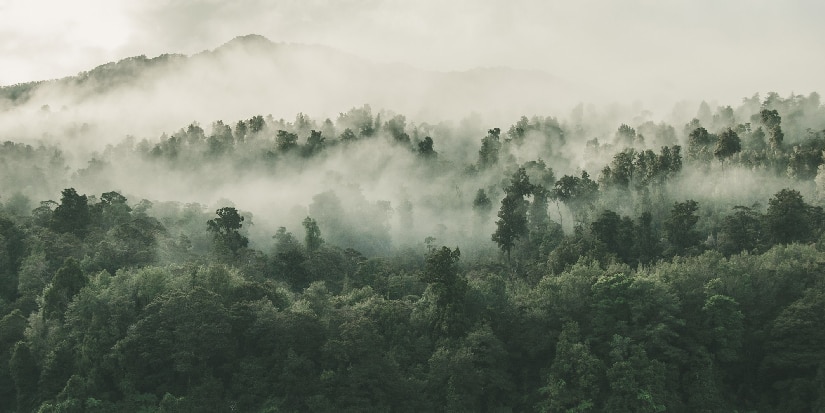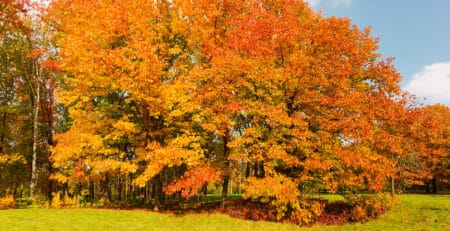How Many Trees Are In The World?
While it is virtually impossible to know how many trees are in the world, satellite imaging has helped procure a rough estimate. A study in the journal of ‘Nature’ reported close to 3.04 Trillion trees on earth. And though this might seem like a lot- it’s not! 3.04 Trillion trees make for almost 422 trees per person. But did you know that a lot of trees are just all in the same place? Depending on where you’re from, how many trees there are in the world for you will be a lot less, maybe even more, than 442 trees.

How Many Trees Were There In The World Before Humans?
Before the advent of man, the earth hosted a whopping 6 Trillion trees-double the current number of trees in the world. Historians estimate that the forest spread must have been around 6 billion hectares of land. Still, now the planet only has a fraction of the trees it used to, thanks to intensive agricultural practices and modern civilization infrastructure. Unfortunately, we continue to lose trees at the rate of approximately 10 billion trees a year.
How Many Trees Were There In The World 100 Years Ago?
The 1920s saw exponential growth in the timber industry due to many constructions and recreational sectors’ developments. Interestingly, the number of trees in the world has grown by 400%, and we now have a lot more trees than we did 100 years before.
Where Are All The Trees?
There might be 3.04 Trillion trees in the world, but their distribution is the real problem. 50% of all the trees in the world are present in the five biggest countries, while two-thirds of all trees are in just ten countries. Leaving just 1990 Billion trees for the rest of the world! It doesn’t seem like an awful lot anymore.
Countries With The Most Trees:
For the most part, the larger a country is, the more trees it is likely to have. Brazil, Columbia, and Indonesia have the highest number of native tree species. The top 10 countries in terms of how many trees they have are below.
Russia- The Country With The Most Trees:
Russia has 642 Billion trees which earn it the title of the country with the most trees! Illegal forests occupy vast stretches of the country- yes, the state can ban trees! 10% of Russia, which is almost twice the size of Spain’s whole country, lies in formerly or presently designed regions as ‘agricultural land.’ For some bizarre reason, the Russian legislation demands that landowners keep these areas free of forests, and they are even liable to pay fines in case of the breach! Yet, most of these areas lie forgotten, covered in scores of trees despite the legal opposition.
How Many Canadian Trees Are There In The World?
The world’s second-largest country is also the second-largest when it comes to how many trees it has. Canada is home to almost 318 Billion trees which occupy around 40% of the region. Not surprisingly, Canada’s forests represent 30% of the whole world’s forests! Spruce trees, which are distinguishable by their needle-like leaves, are the country’s most abundant trees. Pines, much like the Spruce, have needles for leaves but are enclosed within cones. Sugar Maple, known for its beautiful colours and sweet maple syrup, represents the red leaf on the Canadian flag. Another tree, the Eastern White Cedar, labelled the “tree of life,” is also very common in the region.
How Many Trees Are There In Brazil?
Brazil hosts the world’s largest forest- The Amazon. The country has a total of almost 302 Billion trees, but they are in danger! Deforestation rates are incredibly high, and unless prompt action is taken, agribusiness and power generation might collapse, and the country won’t have any trees left to boast about!
 How Many Trees Does The United States of America Have?
How Many Trees Does The United States of America Have?
If you think of the USA, you probably don’t think of trees but maybe you should! Over 55% of the U.S. population gets clean, pollutant-free, drinking-quality water from forested watersheds. The 228 Billion trees of the country include one very special tree as well. The “Great Bristlecone pine” in California’s White Mountains is the World’s Oldest Tree at 5000 years old. Additionally, North America is home to more than 1000 tree species. The country’s national tree is the Oak which symbolizes beauty, diversity, and strength and has linked to the Greek god Zeus.
How Much of China Is Trees?
China has 140 Billion trees which cover approximately 23% of the country’s land. In an attempt to tackle its expanding northern deserts, China launched the Three-North Shelterbelt Project in 1978. Also called the “Great Wall Project,” the plan aims to plant millions of trees along the 2,800-mile border of the northern desert and ultimately increase the world’s forests by 10%. So far, more than 66 billion trees have been planted by the Chinese government. The idea has received mixed reviews but will continue till 2050, as planned. Moreover, the famous Chinese Bamboo tree is the World’s Fastest-Growing Tree at 1.5 inches an hour – and it even holds a Guinness World Record!
Trees of The Democratic Republic Of Congo:
Congo has a total of 101 Billion trees which comprise over 600 tree species. The country has 100-120 Million hectares dedicated to the dense forest, Savannah forests occupy a large part, and protected areas span 26 Million hectares.
How Many Trees Are In Indonesia?
81 Billion of the whole world’s trees are in Indonesia. An estimated 51% of the country is forested, of which 50% is a primary forest- the most biodiverse and carbon-dense form of forests. Indonesia has 4000 species of trees, but only about 120 hardwood species are suited for commercial use.
 How Many Trees Are In Australia?
How Many Trees Are In Australia?
Australia has around 77 Billion trees, of which most are Eucalypts. Eucalyptus trees (gum trees) which include 2,800 different species, cover about 101 Million hectares which amount to approximately 80% of Australian forests.
How Much Of Peru Is Forest?
Peru boasts the 10th-most forested area in any country in the world, with almost half of the country covered by trees. Peru also has the second-largest amazon jungle, “Peruvian Amazonia,” after Brazil.
How Many Trees Are There In India?
An estimated 21.6% of India’s land is in forests, and the country has pledged to increase this coverage by a massive 95 Million hectares by 2030! In 2017, 1.5 Million volunteers helped plant 66 Million trees in Madhya Pradesh’s state- in under 12 hours!
How Many Trees Are In The Rest of The World?
| Countries | Green Profile |
| Afghanistan | 1,350,000 ha |
| Albania | 776,000 ha |
| Algeria | 1,492,000 ha |
| Andorra | 16,000 ha |
| Angola | 23M ha |
| Antigua & Barbuda | 10,000 ha |
| Argentina | 29,400,000 ha |
| Armenia | 459,900 ha |
| Austria | 3,878,000 ha |
| Azerbaijan | 936,000 ha |
| Bahamas | 331,579 ha |
| Bahrain | 515,000 ha |
| Bangladesh | 2,600,000 ha |
| Barbados | 2,000 ha |
| Belarus | 7,894,000 ha |
| Belgium | 667,000 ha |
| Belize | 1,393,000 ha |
| Benin | 2,351,000 ha |
| Bhutan | 3,249,000 ha |
| Bolivia | 57M ha |
| Bosnia & Herzegovina | 2.115M ha |
| Botswana | 11,351,000 ha |
| Brazil | 519,522,000 ha |
| Brunei | Data unavailable |
| Bulgaria | 3,927,000 ha |
| Burkina Faso | 5,649,000 ha |
| Burundi | 172,000 ha |
| Côte d’Ivoire | 10,405,000 ha |
| Cabo Verde | 84,000 ha |
| Cambodia | 3.1M ha |
| Cameroon | 19M ha |
| Central African Republic | 23M ha |
| Chad | 593,000 ha |
| Chile | 16.2M ha |
| Colombia | 60.3 or 64 M ha (disputed) |
| Comoros | 3,000 ha |
| Costa Rica | 2,605,000 ha |
| Croatia | 1,920,000 ha |
| Cuba | 2,870,000 ha |
| Cyprus | 173,000 ha |
| Czech Republic | 2,657,000 ha |
| Denmark | 608,078 ha |
| Djibouti | 6,000 ha |
| Dominica | 45,000 ha |
| Dominican Republic | 1,972,000 ha |
| Ecuador | 12.4M ha |
| Egypt | 70,000 ha |
| El Salvador | 287,000 ha |
| Eritrea | 1,532,000 ha |
| Estonia | 2M ha |
| Eswatini | 590,600 ha |
| Ethiopia | 12,296,000 ha |
| Fiji | 1,014,000 ha |
| Finland | 23M ha |
| France | 16.7M ha |
| Gabon | 22.3M ha |
| Gambia | 480,000 ha |
| Georgia | 2,742,000 ha |
| Germany | 11.4M ha |
| Ghana | 9.17M ha |
| Greece | 3,903,000 ha |
| Grenada | 17,000 ha |
| Guatemala | 3,657 ha |
| Guinea | 3M ha |
| Guinea-Bissau | 2,022,000 ha |
| Haiti | 101,000 ha |
| Holy See | Data unavailable |
| Honduras | 6.3M ha |
| Hungary | 2,029,000 ha |
| Iceland | 30,000 ha |
| Iran | 11,075,000 ha |
| Iraq | 825,000 ha |
| Ireland | 770,020 ha |
| Israel | 154,000 ha |
| Italy | 9,297,078 ha |
| Jamaica | 335 900 ha |
| Japan | 25M ha |
| Jordan | 98,000 ha |
| Kazakhstan | 12M ha |
| Kenya | 37M ha |
| Kiribati | 12,000 ha |
| Kuwait | 6,000 ha |
| Kyrgyzstan | 1,123,200 ha |
| Laos | 1.49M ha |
| Latvia | 3.354M ha |
| Lebanon | 139,376 ha |
| Lesotho | 43,000 ha |
| Liberia | 6.69M ha |
| Libya | 217,000 ha |
| Liechtenstein | 6,865 ha |
| Lithuania | 8M ha |
| Luxembourg | 1,055 ha |
| Madagascar | 12,553,000 ha |
| Malawi | 3,237,000 ha |
| Malaysia | 20,456,000 ha |
| Maldives | 3,716 ha |
| Mali | 12,572,000 ha |
| Malta | 4B ha |
| Marshall Islands | 13,000 ha |
| Mauritius | 47,159 ha |
| Mexico | 64M ha |
| Micronesia | 64,000 ha |
| Moldova | 4B ha |
| Monaco | 42 ha |
| Mongolia | 18.3M ha |
| Montenegro | 137.480 ha |
| Morocco | 5,131,000 ha |
| Mozambique | 32M ha |
| Myanmar (formerly Burma) | 29M ha |
| Namibia | 7,290,000 ha |
| Nauru | Almost None |
| Nepal | 3,636,000 ha |
| Netherlands | 365,000 ha |
| New Zealand | 10M ha |
| Nicaragua | 3,114,000 ha |
| Niger | 1,266,000 ha |
| Nigeria | 9,041,000 ha |
| North Korea | 6,187,000 ha |
| North Macedonia | 998,000 ha |
| Norway | 13.4M ha |
| Oman | 1,000 ha |
| Pakistan | 4.57M ha |
| Palau | 46,300 ha |
| Palestine | 9,000 ha |
| Panama | 310,800 ha |
| Papua New Guinea | 28,726,000 ha |
| Paraguay | 17,582,000 ha |
| Philippines | 5.7M ha |
| Poland | 9.1M ha |
| Portugal | 3.3M ha |
| Qatar | None |
| Romania | 6,249 million ha |
| Rwanda | 435,000 ha |
| Saint Kitts & Nevis | 11,000 ha |
| Saint Lucia | 47,000 ha |
| Saint Vincent & the Grenadines | Data unavailable |
| Samoa | 276,300 ha |
| San Marino | Almost None |
| Sao Tome & Principe | 97,800 ha |
| Saudi Arabia | 977,000 ha |
| Senegal | 8,473,000 ha |
| Serbia | 2,252,000 ha |
| Seychelles | 41,000 ha |
| Sierra Leone | 2,726,000 ha |
| Singapore | 2,000 ha |
| Slovakia | 2M ha |
| Slovenia | 1,094,000 ha |
| Solomon Islands | 4,297,600 ha |
| Somalia | 6,747,000 ha |
| South Africa | 9,241,000 ha |
| South Korea | 3.97M ha |
| South Sudan | 19,166,700 ha |
| Spain | 18,173,000 ha |
| Sri Lanka | 1,249,300 ha |
| Sudan | 69,949,000 ha |
| Suriname | 15.3M ha |
| Sweden | 23M ha |
| Switzerland | 1.31M ha |
| Syria | 190,000 ha |
| Tajikistan | 410,000 ha |
| Tanzania | 35.3M ha |
| Thailand | 16,320,000 ha |
| Timor-Leste | 742,000 ha |
| Togo | 287,000 ha |
| Tonga | 54,900 ha |
| Trinidad & Tobago | 226,000 ha |
| Tunisia | 1,006,000 ha |
| Turkey | 21.7M ha |
| Turkmenistan | 4,127,000 ha |
| Tuvalu | 1,000 ha |
| Uganda | 959,268 ha |
| Ukraine | 9,705,000 ha |
| United Arab Emirates | 317,000 ha |
| United Kingdom | 3.21M ha |
| Uruguay | 1,744,000 ha |
| Uzbekistan | 3,295,000 ha |
| Vanuatu | 1,228,100 ha |
| Venezuela | 45,822,250 ha |
| Vietnam | 12,931,000 ha |
| Yemen | 1,955,000 ha |
| Zambia | 75,200,000 ha |
| Zimbabwe | 15,624,000 ha |
What Countries Have The Best Tree Density?
Another way to categorize countries is tree density. Some studies have even likened GDP with the tree density of a nation. The countries with the best tree density include Finland, Sweden, Slovenia, Taiwan, French Guiana, and Equatorial Guinea.
Tree Density of Finland:
Finland has a tree density of 72 644 trees per square kilometer. Studies also indicated that Finnish forests are denser than most forests of the world. Finland is Europe’s Most Forested Country, with 70% of the country covered with more than 22 Billion trees. Plus, Finland plants 150 Million trees every year, so the numbers will rise.
 Tree Density of Sweden:
Tree Density of Sweden:
Sweden has nearly doubled its forests in the past 100 years. Now, 70% of the country is forested, with 69 161 trees spread per square kilometer. Approximately 10% of the world’s timber, pulp, and paper come from Sweden. Plus, the country plants 380 Million plants annually.
Tree Density of Slovenia:
Slovenia’s tree density is 71,131 trees per square kilometer, and 60% of the region is greenery. The Chamois tree and the Linden tree, both abundant across the country, are two significant national symbols. Over sixty forest associations are present in Slovenia- 45% of these grow deciduous trees while 55% grow conifers.
Tree Density of Taiwan:
With a tree coverage of 62,975 trees per square kilometer, Taiwan is home to the famous Money Tree! The money tree doesn’t require a lot of special care but is thought to attract luck and wealth and be an efficient air purifier. Plus, it’s pet-friendly, so occasional snacking by your feline friends won’t harm them- the pets, at least. Now, you might think the legend of the money tree goes back many centuries, but it dates back to the 1980s. A Taiwanese truckdriver planted the tree in his field and managed to multiply it so many times that he quickly became wealthy, hence the name “money tree.”
Tee Density of French Guiana:
French Guiana is home to at least 1500 tree species which provide a density of almost 60,326 trees per square kilometer. One-fifth of the World’s High Biodiversity Wilderness Areas are here. You’ll be surprised to find out that 98.9% of the country is a majorly virgin forest! But where do all the people live? For one, the population is only 294,071 people, and they are in the metropolitan area of the state capital, Cayenne.
 Tree Density of Equatorial Guinea:
Tree Density of Equatorial Guinea:
Equatorial Guinea has a tree density of 61,791 trees per square kilometer. The green part on the country’s flag symbolizes the Silk-cotton tree, also called the “god tree,” under which the first treaty with Spain was signed. An area of 2.5 Million hectares is forested, which accounts for 93% of the country.
What Countries Have The Most Trees Per Person?
“Tree wealth” can also be measured in terms of the most significant number of trees per person. As per the entire world’s population and tree resources, there are 422 trees for every individual. However, as previously discussed, there is a massive disparity in the three populations of different countries. The countries with the best ratio include Canada with 8,953 trees per person, Russia with 4,461 trees per person, and The Central African Republic with 5,152 trees per person. 53.1 Million hectares of Bolivia account for 5,465 trees per person, while Gabon’sdry’ forests spanning 77% of the region constitute 8,131 trees per person.
Moreover, Guyana and French Guiana also have 14,692 trees and 20,226 trees per person, respectively. However, it is essential to note that their populations are less than a million, so such a high number of trees per person is not surprising. On the contrary, India has a whopping 36 Billion trees, but its population is also more than a billion. Hence, every individual would get just 30 trees each. On the other hand, desert countries have little to no trees, and thus in a country like Egypt, there is only one tree per person.
What Countries Have No Trees?
You might wonder if it’s even possible for a country to not have trees, but apparently, it is! According to the World Bank’s definition, there are four countries without any forest at all- Qatar, Greenland, San Marino, and Oman.
 Qatar – A True Desert:
Qatar – A True Desert:
Qatar is a true desert in every way- it has a sub-tropical, dry, hot desert climate with very little to no rainfall. Qatar has everything- from futuristic skyscrapers, ultramodern architecture, large reserves of petroleum and gas, and even the world’s greatest airline, yet it has no trees!
But did you know that Qatar is all set on creating the World’s Largest Manmade Forest with over 95,000 trees! Nakheel Landscapes started the project in November 2016 with an area of 12 square kilometers. Trees selected for the project are ones requiring very little water. Furthermore, treated water from the Doha North Sewage Treatment Works Plant will irrigate the forest through a fully automated process.
Greenland Is Not Really Green!
The Green in Greenland and Ice in Iceland should be the other way around because Greenland is icy, and Iceland is beautifully lush! Well, Greenland wasn’t always green. Historians reckon it was very much green and grassy till the summer of A.D. 982, about 2.5 million years ago. As for the name, Erik Red, a murder who had been exiled to the island, named it to encourage settlement in the area.
Does Oman Not Have Any Forests?
According to the World Bank, Oman does not have any forests. But this might be a thing of the past now as the Sultanate plans to plant millions of trees to reduce carbon dioxide emissions. By planting more than half a trillion trees, 205 gigatons of Carbon can be eliminated from the earth! This elimination almost equals half the carbon dioxide produced by the planet since 1960! In light of a potential crisis, the Ministry of Environment and Climate Affairs, in collaboration with the Petroleum Development Oman, is working on a national initiative to plant 10 Million trees throughout the Sultanate within the next ten years. This goal is also expected to benefit the region regarding biodiversity, wildlife habitat restoration, countering land degradation, and reaping economic benefits.
Faroe Islands- A land of No Trees:
The country doesn’t have any native trees except for a few woody plants. Archeological findings of trees and branches dating back to 2300 BC indicate that some Hazel and Birch trees had inhabited the area before civilization.
Haiti- A Glimpse of What Deforestation Can Do:
Almost 60% of Haiti’s land was covered in trees until 1923, but the country fell prey to massive deforestation. In 1954, Hurricane Hazel drowned the trees on the island, and along with continued deforestation, only 2% of the region still had trees in 2006. The absence of trees meant the lack of tree products, and therefore, Haiti suffered great economic losses due to this environmental negligence. Only about 1% of the area remains forested, and Haiti has been declared one of the world’s most deforested countries.
How Many Trees Will There Be In The World By 2050?
Studies by the Center For Global Development dictate that the world will lose around 1 million square miles of trees to deforestation by 2050. As the world population increases exponentially, we will need more land, agricultural resources, and forest products to meet their demands. By 2050, middle and small economy countries might have only 1% forest coverage, and the number of trees in the world might be reduced to 2 Trillion. On the bright side, though, with the right policies in place and a global collaborative effort, we can potentially manage to turn the tables and get our tree populations back!
How Many Trees Are In The World- Does It Matter?
With all this tree talk, you might think, “Do we need more trees when we’ve been doing just fine till now?” Apart from the apparent reason for needing oxygen to breathe, trees are an asset to humans. They filter our air, block noise pollution, lessen the blow of floods and even prevent soil erosion. Trees improve water quality and act as sponges that collect and filter rainwater before gradually releasing it into streams. Scientists even speculate that planting enough trees can solve global warming and climate change once and for all!
Additionally, like all forms of nature, trees are therapeutic and render certain psychological and health benefits. The Japanese practice of ‘Topiary therapy’ has proven effects like improved heart rate and blood pressure, stress reduction, and an enhanced immune system. Studies from Harvard have even shown that living near trees increases life expectancy. Not to mention the supply of fruits, leafy vegetables, and other healthy yummy goodies we get from trees. Trees just keep on giving and giving and giving- in short, they are irreplaceable, and we can’t afford to lose them!
Can there be life without trees?
If trees disappeared overnight, so would biodiversity, quite possibly including the human race itself! Trees are at the bottom of the food chain- but that doesn’t mean they’re not important! In fact, that makes them all the more important because they provide the energy to be utilized by other organisms and thus, directly fuel the food chain. As Professor Jayme Prevedello puts it, “There would be massive extinctions of all groups of organisms- both locally and globally.” Truth be told, trees don’t need us as much as we need them! Without trees, our planet might not even be able to sustain us anymore!
Still, if we could somehow manage to survive a tree apocalypse, the real question withstands- ‘Would we want to live in a world without trees?’
Can We Run Out Of Trees?
We are not running out of trees, especially as certain countries continue efforts of reafforestation. But that’s not to say that we can’t ever run out of trees! Deforestation is not the only factor contributing to trees’ loss, but some natural wildfires can also cause significant damage. For instance, the Australian fires caused a loss of 21% of trees in the region. The Amazon
Rainforest has also had 44,013 outbreaks in 2020 alone. Some experts have even estimated that the earth could lose all of its trees within 300 years- definitely not something we can ignore!
The bottom line is that while 3 Trillion may seem like a lot of trees to the common man, we can’t afford to go all “that’s a lot of trees!”- because it’s not! If policies to curb deforestation are not effectively implemented, we might not have any trees left to count! So, when our future generations ask, “How many trees are there in the world?” we must make sure they’ll get an answer! The effort needs to be completed today!







